MARK BANDO'S WEBSITE
Helmet Stencils
One of the distinctive forms of insignia worn by the 101st Airborne in WW2 was Helmet Stencils. After the chaos of an Airborne landing, with personnel of various sub units mixed together on the ground, quick assembly by units was essential for carrying out a mission. Symbols readily visible on helmets were expected to facilitate the re-assembly process. Each regiment and the support battalions had a symbol stenciled in white paint on the left and right side of the helmet.
In England before the Normandy Invasion, these were first applied to the steel pots only. Later, stencils were also applied to helmet liners. Although some regimental stencils were applied without a battalion 'tic', a small dash was usually added at the 12 oclock, 3 oclock, 6 oclock, or 9 oclock positions, to designate battalions, in clockwise order. HQ was at the top, 1st Bn at the 3 oclock position, 2d battalion at the 6 oclock position, and 3rd Bn at the 9 oclock position.
The Infantry regiments were represented by playing card symbols,Diamonds for 501, Hearts for 502, Spades for 506th, Clubs for the 327th Glider Infantry. Due to a foul-up the entire 3rd Bn of the 506th jumped into Normandy with their Bn tic in the 1st Bn position (3 oclock, instead of 9 oclock), This was corrected later in WW2. All units also utilized the standard ETO stencils of vertical and horizontal bars along the rear of the helmet for officers and non coms These markings were clear signals to enemy snipers and were sometimes covered or eliminated in combat.
Application of the Stencils
Individual veterans have stated that the markings were re applied and the steel pot re-painted after each mission. This is probably true in most cases. Examination of the few surviving original examples with provenance tend to show outlines of larger markings, under a layer of paint and mostly overlapped by the more evident(newer) marking.
It is also probable that unit markings were not applied to the 101st helmet LINERS until after Bastogne, probably when back at Camp Mourmelon le Petit, in March of 1945.
Some tactical markings were neatly done, using actual stencils, while others were painted freehand. The supply sergeant of each company or battery was responsible for applying the stencils, but he usually delegated that job to men of lower rank. According to 101st historian George Koskimaki, this job was sometimes given as a punishment detail.
As a general rule, the overall size of tactical markings tended to get smaller as the war progressed, and most tended to be applied relatively close to the bottom rim, although some period photos exist showing them applied higher-up.
Don Burgett of A/506th says that after Normandy, all the steel helmets in Able Co. 506th were totally repainted. When it came time to apply those 1/506th stencils, each man was expected to apply his own. Some men with no artistic ability, asked Don to paint theirs, so he did perhaps a half dozen A/506th helmets for Holland. But this demonstrates how a very wide variance of styles, sizes and placement could result, even within a single company. Don applied his freehand. Others in the same company may have been done using cut stencils.
The helmet of LTC Cecil L. Simmons, the last C.O. of 3rd Bn 502 PIR, is painted a dark green color, with the stencils added. Simmons told me this darker shade was applied in summer, 1945, during occupation duty, so the helmets would look better on parade details.
Don Burgett adds that some men pounded dents into the crown of their steel pots, because they liked to sit on them during breaks, and the dents tended to make them roll around less, when seated on them. Of course they had no idea at the time, that these tin hats would later become almost sacred objects to collectors of Airborne memorabilia.
Markings for Specific Divisional Units
The members of divisional HQ wore a square stencil with tics to designate Signal Co., MPs, Ordinance, etc.
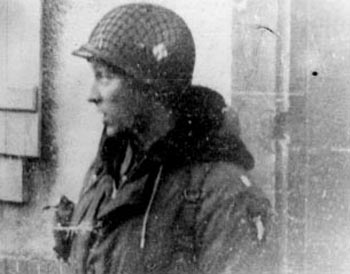 Photo 1) depicts LTC George Griswold as commander of 3rd Bn 501 PIR in early 1945, wearing the diamond stencil with tic at 9 oclock.
Photo 1) depicts LTC George Griswold as commander of 3rd Bn 501 PIR in early 1945, wearing the diamond stencil with tic at 9 oclock.
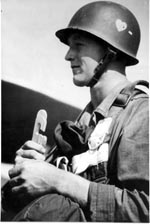 Photo 2) depicts an unknown member of C/502 awaiting the postwar 'pay jump' at Auxerre, France in 1945. As with all 1st
battalion helmets, the 'tic' appears at the 3 o'clock position in relation to the regimental symbol. Photo courtesy Frank Miller.
Photo 2) depicts an unknown member of C/502 awaiting the postwar 'pay jump' at Auxerre, France in 1945. As with all 1st
battalion helmets, the 'tic' appears at the 3 o'clock position in relation to the regimental symbol. Photo courtesy Frank Miller.
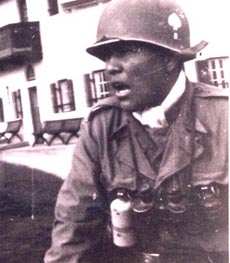 Photo 3) depicts "Chief", a Native American member of D/506th wearing spades with a tic at the 6 oclock position for 2d Bn.
Photo c/o Louis Truax
Photo 3) depicts "Chief", a Native American member of D/506th wearing spades with a tic at the 6 oclock position for 2d Bn.
Photo c/o Louis Truax
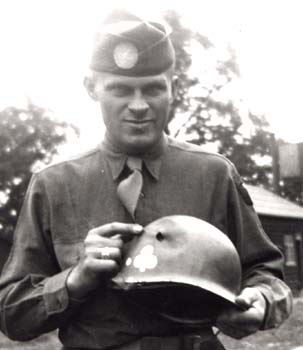 The symbol for the 327th Glider Infantry Regiment was a club (3-leaf clover). Ed Pieczatowski's helmet was shot off by a grenadier of the 17th SS division near Montmartin en Graignes,
France, during the Normandy invasion. The bullet grazed Ed's skull and knocked him down. Here he is pointing to the evidence of his close escape from death, but we can also see the 327th stencil (Ed was in Company 'G').c/o Ed Pieczatowski.
The symbol for the 327th Glider Infantry Regiment was a club (3-leaf clover). Ed Pieczatowski's helmet was shot off by a grenadier of the 17th SS division near Montmartin en Graignes,
France, during the Normandy invasion. The bullet grazed Ed's skull and knocked him down. Here he is pointing to the evidence of his close escape from death, but we can also see the 327th stencil (Ed was in Company 'G').c/o Ed Pieczatowski.
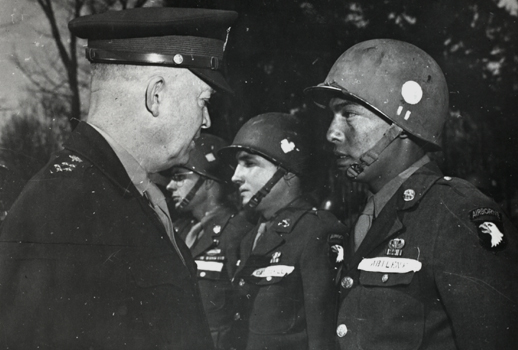 This photo was taken in March, 1945, when the 101st Airborne Division received a Presidential
Unit citation for defending Bastogne. This shows stencils from RHQ/501 PIR, 1st Bn 502 PIR, and the 463rd PFAB. Note the
rough edges around the insignia, typical of late-war paint-jobs. By then, many of the helmets had been repainted once or twice,
covering-over the previous paint and stencils. The name tags Ike is viewing are not the soldiers' names, but rather their
home towns, a detail which always interested General Eisenhower.
This photo was taken in March, 1945, when the 101st Airborne Division received a Presidential
Unit citation for defending Bastogne. This shows stencils from RHQ/501 PIR, 1st Bn 502 PIR, and the 463rd PFAB. Note the
rough edges around the insignia, typical of late-war paint-jobs. By then, many of the helmets had been repainted once or twice,
covering-over the previous paint and stencils. The name tags Ike is viewing are not the soldiers' names, but rather their
home towns, a detail which always interested General Eisenhower.
The Native American trooper shown in the foreground is
Milford Shopteese of Abilene, KS. S.C. photo
Illustrated below, are some of the stencils used by smaller units within the WWII 101st Airborne Division:
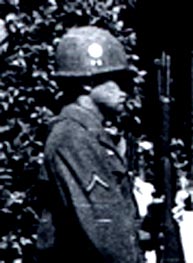
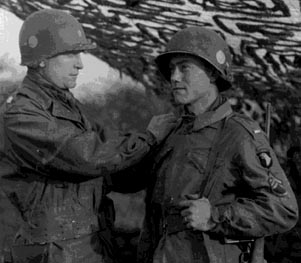 The artillery units utilized a white circle, representing a cannonball. Above left is the symbol of the 463d PFA Bn, with two tics below the ball at 6 o'clock. Above right is a Battlefield Commission ceremony in Alsace in early '45. LTC Clarence Nelson, the 907th GFA Bn commander is promoting S/Sgt George Turner to 2d Lt. Note that Nelson wears his 'tic properly at the 9 o'clock position, while Turner's is incorrectly placed at the 3 o'clock position, which is the symbol for the 321st GFA Bn. Confusion over where and how to place the tics was commonplace. photos c/o Bob Probst and Deenie W.
The artillery units utilized a white circle, representing a cannonball. Above left is the symbol of the 463d PFA Bn, with two tics below the ball at 6 o'clock. Above right is a Battlefield Commission ceremony in Alsace in early '45. LTC Clarence Nelson, the 907th GFA Bn commander is promoting S/Sgt George Turner to 2d Lt. Note that Nelson wears his 'tic properly at the 9 o'clock position, while Turner's is incorrectly placed at the 3 o'clock position, which is the symbol for the 321st GFA Bn. Confusion over where and how to place the tics was commonplace. photos c/o Bob Probst and Deenie W.
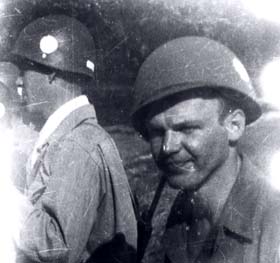 Members of the 377th Parachute Field Artillery Bn. wore the circular cannonball, with a tic at 6 o'clock. photo courtesy Robert Probst
Members of the 377th Parachute Field Artillery Bn. wore the circular cannonball, with a tic at 6 o'clock. photo courtesy Robert Probst
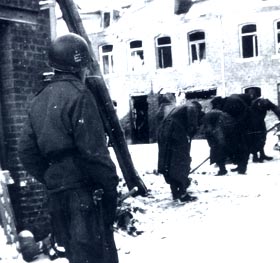 The 326th Airborne Engineeer Bn used a capital 'E' stencil. Because it was a battalion rather than a regiment, the 'tics' symbolized company, rather than battalion designations. The trooper shown guarding German PWs who are clearing rubble from the streets of Bastogne, is a member of HQ company, with a tic at 12 o'clock. A, B, and C companies had tics at 3 o'clock, 6 o'clock, and 9 o'clock, respectively. photo c/o John Tocco
The 326th Airborne Engineeer Bn used a capital 'E' stencil. Because it was a battalion rather than a regiment, the 'tics' symbolized company, rather than battalion designations. The trooper shown guarding German PWs who are clearing rubble from the streets of Bastogne, is a member of HQ company, with a tic at 12 o'clock. A, B, and C companies had tics at 3 o'clock, 6 o'clock, and 9 o'clock, respectively. photo c/o John Tocco
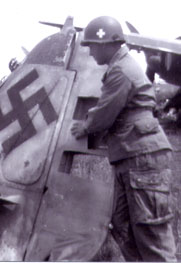 The medic standing at right, is Henry Hauser. He wears a helmet painted with the white Geneva Cross worn by the 326th Airborne Medical Company. He is inspecting the vertical stabilizer of a German fighter plane, which was abandoned along the autobahn in Bavaria, enroute to Berchtesgaden, in April, 1945.
The medic standing at right, is Henry Hauser. He wears a helmet painted with the white Geneva Cross worn by the 326th Airborne Medical Company. He is inspecting the vertical stabilizer of a German fighter plane, which was abandoned along the autobahn in Bavaria, enroute to Berchtesgaden, in April, 1945.
photo courtesy H. Hauser
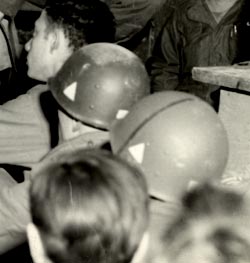
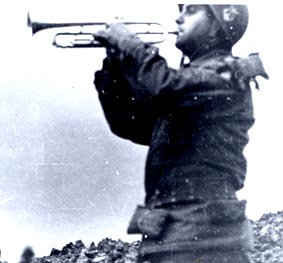 The 81st Airborne Anti-Aircraft and Antitank Bn wore a triangle (upper left). The 101st Division Band wore a 'Lyre' (upper right). photos c/o Deenie W. and Richard Winters.
The 81st Airborne Anti-Aircraft and Antitank Bn wore a triangle (upper left). The 101st Division Band wore a 'Lyre' (upper right). photos c/o Deenie W. and Richard Winters.
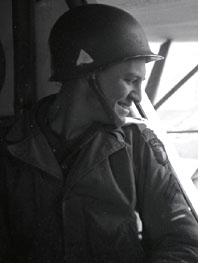 Another example of the triangular stencil used
by the 81st Abn AA/AT Bn. worn here by a soldier sitting in a Glider.
Another example of the triangular stencil used
by the 81st Abn AA/AT Bn. worn here by a soldier sitting in a Glider.
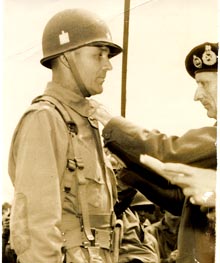 This photo of Max Taylor being decorated by Field Marshall Montgomery at Cherbourg in July, 1944 gives a good view of the 101st Division HQ stencil. U.S. Army photo.
This photo of Max Taylor being decorated by Field Marshall Montgomery at Cherbourg in July, 1944 gives a good view of the 101st Division HQ stencil. U.S. Army photo.
Images and information on Insignia pages Copyright Mark Bando, September, 2000.

















